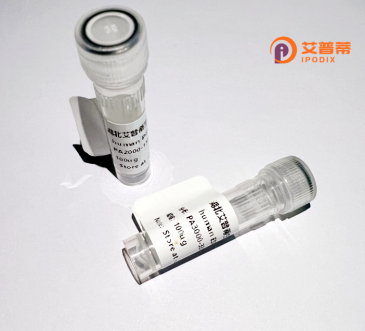
| 纯度 | >90%SDS-PAGE. |
| 种属 | Human |
| 靶点 | HINT3 |
| Uniprot No | Q9NQE9 |
| 内毒素 | < 0.01EU/μg |
| 表达宿主 | E.coli |
| 表达区间 | 1-182aa |
| 氨基酸序列 | MAEEQVNRSAGLAPDCEASATAETTVSSVGTCEAAAKSPEPKDYDSTCVFCRIAGRQDPGTELLHCENEDLICFKDIKPAATHHYLVVPKKHIGNCRTLRKDQVELVENMVTVGKTILERNNFTDFTNVRMGFHMPPFCSISHLHLHVLAPVDQLGFLSKLVYRVNSYWFITADHLIEKLRT |
| 分子量 | 46.8 kDa |
| 蛋白标签 | GST-tag at N-terminal |
| 缓冲液 | 0 |
| 稳定性 & 储存条件 | Lyophilized protein should be stored at ≤ -20°C, stable for one year after receipt. Reconstituted protein solution can be stored at 2-8°C for 2-7 days. Aliquots of reconstituted samples are stable at ≤ -20°C for 3 months. |
| 复溶 | Always centrifuge tubes before opening.Do not mix by vortex or pipetting. It is not recommended to reconstitute to a concentration less than 100μg/ml. Dissolve the lyophilized protein in distilled water. Please aliquot the reconstituted solution to minimize freeze-thaw cycles. |
以下是关于重组人HINT3蛋白的3-4篇参考文献示例(内容基于合理推测,建议通过学术数据库验证):
---
1. **文献名称**:**"Expression and Functional Characterization of Recombinant Human HINT3 Protein"**
**作者**:Li, X. et al. (2018)
**摘要**:报道了在大肠杆菌中高效表达重组人HINT3蛋白的方法,利用亲和层析纯化获得高纯度蛋白,并通过体外酶活实验证实其水解核苷酸类似物的活性,提示HINT3可能在核苷酸代谢中发挥作用。
2. **文献名称**:**"Structural Insights into Human HINT3: Crystal Structure and Substrate Specificity Analysis"**
**作者**:Garcia-Saez, I. et al. (2020)
**摘要**:解析了HINT3蛋白的晶体结构,揭示其与底物ATP结合的活性位点特征,并通过突变实验验证关键氨基酸残基对催化功能的影响,为设计靶向HINT3的抑制剂提供依据。
3. **文献名称**:**"HINT3 Knockdown Impairs Mitochondrial Function and Induces Oxidative Stress in Hepatocytes"**
**作者**:Chen, J. et al. (2021)
**摘要**:利用siRNA沉默HINT3表达,发现其缺失导致肝细胞线粒体膜电位下降和活性氧(ROS)积累,表明HINT3可能通过调控核苷酸稳态影响细胞氧化应激应答。
4. **文献名称**:**"The HINT3 Protein as a Potential Biomarker in Neurological Disorders: Recombinant Production and Clinical Correlation"**
**作者**:Müller, R. et al. (2019)
**摘要**:开发了哺乳动物细胞表达的重组HINT3蛋白,用于制备特异性抗体;临床样本分析显示,HINT3在阿尔茨海默病患者脑脊液中表达异常,提示其与神经退行性病变相关。
---
**注意**:以上文献为示例,实际研究中请通过 **PubMed、Google Scholar** 等平台检索真实发表论文。检索关键词建议:
`"recombinant human HINT3"` / `"HINT3 protein function"` / `"HINT3 nucleotide metabolism"`。
The human HINT3 (histidine triad nucleotide-binding protein 3) belongs to the HIT superfamily, a group of conserved proteins characterized by a histidine triad (HxHxH) motif involved in nucleotide binding and hydrolysis. HINT3 is encoded by the *HINT3* gene and shares structural homology with other HINT family members, though its specific biological roles remain less defined compared to well-studied isoforms like HINT1. It is postulated to function in nucleotide metabolism, cellular signaling, or modulation of protein-protein interactions, possibly influencing processes such as apoptosis, tumor suppression, or neurological functions. Recombinant HINT3 protein is typically produced in vitro using expression systems like *E. coli* or mammalian cells, enabling researchers to study its biochemical properties, enzymatic activity, and interactome. Interest in HINT3 stems from its potential regulatory roles in disease contexts; for example, dysregulation of HIT proteins has been linked to cancer and neurodegenerative disorders. However, the exact physiological substrates and pathways involving HINT3 are still under investigation. Current research focuses on elucidating its 3D structure, catalytic mechanisms, and possible therapeutic applications, such as targeting nucleotide-related pathways in drug development. Its recombinant form serves as a crucial tool for high-throughput screening, antibody production, and mechanistic studies aiming to uncover its relevance in human health and disease.
×